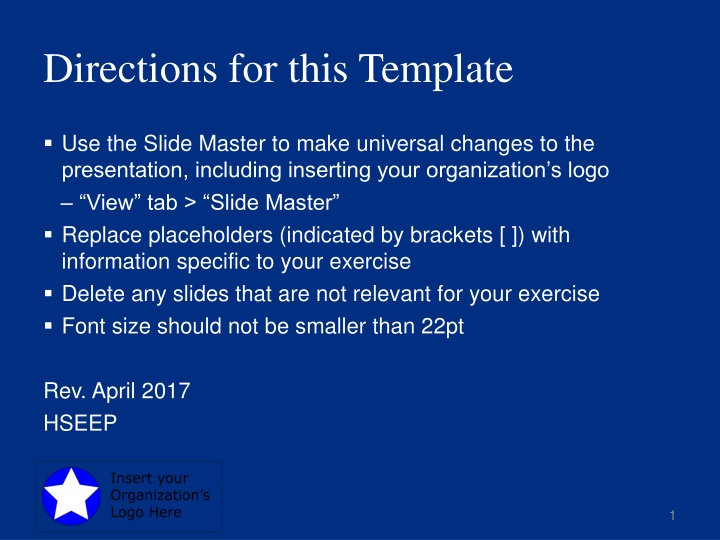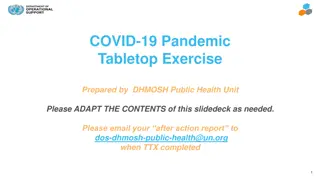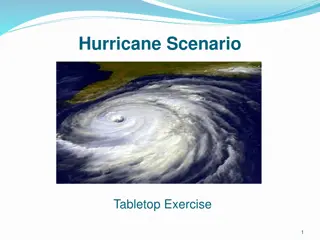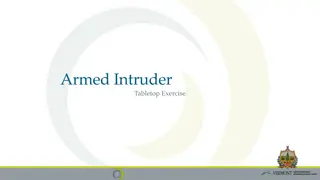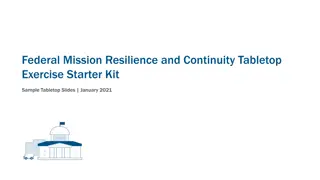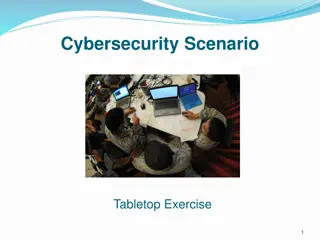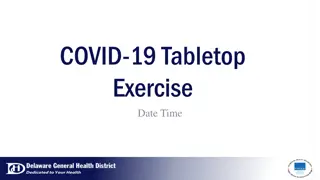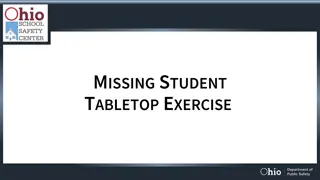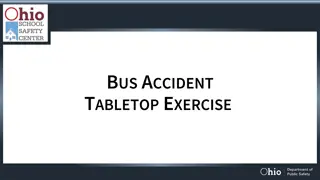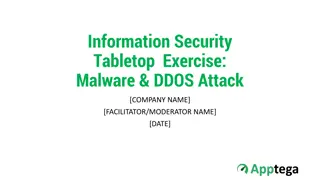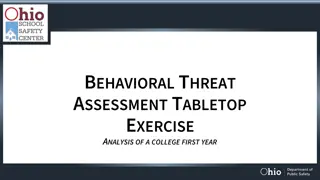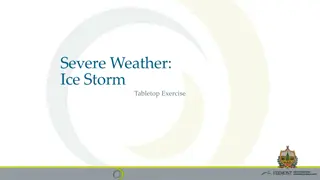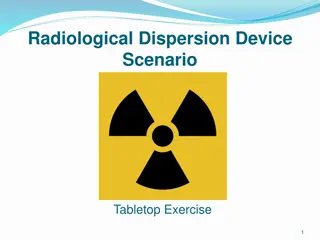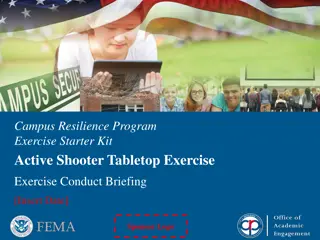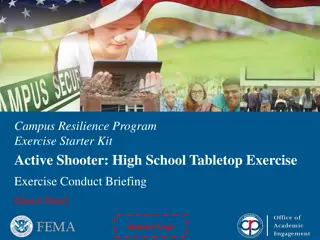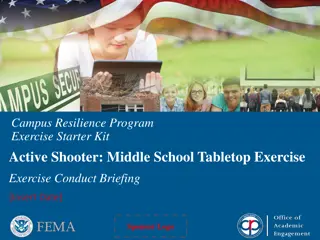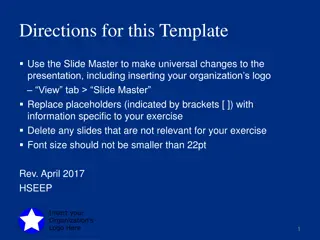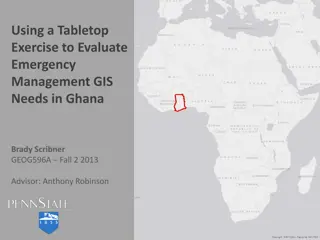Higher Education COVID-19 Tabletop Exercise Facilitator Briefing
Facilitate a tabletop exercise focusing on COVID-19 preparedness for higher education institutions. Customize templates, review manuals, and engage participants to enhance readiness. Discuss repopulation, health monitoring, containment, and shutdown protocols to ensure effective response strategies against the pandemic.
Download Presentation

Please find below an Image/Link to download the presentation.
The content on the website is provided AS IS for your information and personal use only. It may not be sold, licensed, or shared on other websites without obtaining consent from the author.If you encounter any issues during the download, it is possible that the publisher has removed the file from their server.
You are allowed to download the files provided on this website for personal or commercial use, subject to the condition that they are used lawfully. All files are the property of their respective owners.
The content on the website is provided AS IS for your information and personal use only. It may not be sold, licensed, or shared on other websites without obtaining consent from the author.
E N D
Presentation Transcript
Directions for this Template Use the Slide Master to make universal changes to the presentation, including inserting your organization s logo View tab > Slide Master Replace placeholders (indicated by brackets [ ]) with information specific to your exercise Delete any slides that are not relevant for your exercise Font size should not be smaller than 22pt Rev. April 2017 HSEEP 1
Institutes of Higher Education COVID 19 Tabletop Exercise Facilitator Briefing [Date]
Welcome and Overview [Name] [Title (e.g., Exercise Director or Lead Planner)] [Organization] 3
Exercise Overview Exercise scope: Exercise Type: Tabletop Exercise Duration: Location(s): Exercise parameters: Mission area(s): Response
Objectives and Core Capabilities Objective 1: Examine the ability of IHE to conduct repopulation of campuses. Aligns to Objective 2: Discuss the monitoring of health conditions to detect COVID-19 infection in the campus environment. Aligns to 5
Objectives and Core Capabilities Objective 3: Assess the ability of IHE to perform containment to prevent spread of the COVID-19 when detected. Aligns to Objective 4: Discuss the considerations for shutdown if necessitated by severe conditions in accordance with public health guidance. Aligns to 6
Format The facilitator will review the Situation Manual (SitMan), Exercise Briefing Slides, Exercise Evaluation Guides, and Participant Feedback Forms and begin filling in the blue and gray text to customize the information to their locality. The scenarios can also be adjusted for difficulty by changing certain scenario elements such as number of persons affected or by incorporating elements into the document that are in the gray Instructor Notes box throughout this document. Discussion questions are listed in the Situation Manual. Supplemental questions can be found in the facilitator s guide. 7
Participant Roles and Responsibilities Players: Players are personnel who have an active role in discussing or performing their regular roles and responsibilities during the exercise. Players discuss or initiate actions in response to the simulated emergency. Observers: Observers do not directly participate in the exercise. However, they may support the development of player responses to the situation during the discussion by asking relevant questions or providing subject matter expertise. Facilitators: Facilitators provide situation updates and moderate discussions. They also provide additional information or resolve questions as required. Key Exercise Planning Team members also may assist with facilitation as subject matter experts (SMEs) during the exercise. Evaluators: Evaluators are assigned to observe and document certain objectives during the exercise. Their primary role is to document player discussions, including how and if those discussions conform to plans, polices, and procedures. 8
Exercise Setup Exercise setup should be planned in advance Setup includes: Set up the Facility/Room in plenary or in groups, depending on how you want to conduct the TTX Allow space for food/refreshments Audio/Visual requirements make sure they work Lay out supplies (paper, pens, markers, etc.) Lay out badges, name tents, and table tents Set up registration and table/breakout identification 9
Exercise Setup- Web Based Exercise setup should be planned in advance for Breakout groups considerations Web-Based Setup includes: Utilizing a Meeting tool that allows for Break out groups within the session (e.g. Zoom if security protocols allow) Utilizing a multi-session meeting by setting up individual sessions for each Module and additional sessions for each break out group per module for discussion Utilizing a combination of multi-session meeting for each module and phone sessions for breakout groups 10
Facilitation Opening remarks and multimedia presentations should be given to introduce the participants to the exercise and guide them through the process. This exercise will be a moderated discussion. Moderated discussions provide participants the opportunity to hear how various functional areas would respond to the presented incident and ask questions to fellow participants. The facilitator will run through a series of discussion questions to get participants to walk through their plans, policies, and procedures in response to the presented incident. 11
Tips for Facilitation Stay neutral on content Listen actively Ask open-ended questions Paraphrase to Clarify Encourage everyone to participate Keep control of the discussion and time Emphasize the low-stress, no-fault environment 12
Briefing Slides A breakdown of the exercise slides is provided in your Facilitator Handbook Supplemental questions for participants are also include in your Facilitator Handbook 13
Hot Wash The Hot Wash is an important part of the exercise process. This is an opportunity for players to discuss what they felt were the highs and lows of the discussion. Ask players to give their opinion on what aspects of the discussed response went well, and what can be improved, based on their agencies role in the response. 14
